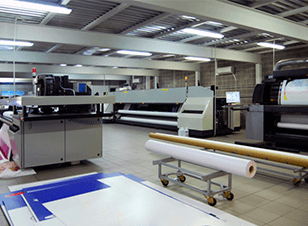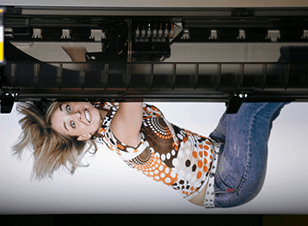 Remember when you were a kid and you would make birthday banners by printing out each individual letter onto an A4 size piece of paper? It took so much time, wasted so much paper and didn’t really last long did it? Oh, those were the days!
Remember when you were a kid and you would make birthday banners by printing out each individual letter onto an A4 size piece of paper? It took so much time, wasted so much paper and didn’t really last long did it? Oh, those were the days!
Large format printers take all the pain away from producing banners and signs and allow us to make a huge impact at a large scale. Whether it’s an advertisement on a billboard, a simple gig poster, wallpaper artwork for the office or event signage, none of this can actually be achieved without large format printers. Large format printing enables the sophisticated production of huge graphics. Let’s take a look at how this works.
Benefits of Large Format Printing
- Allows you to print any ‘A’ series paper size dimensions, from A8 to A0, or at large custom dimensions.
- Choose from a variety of durable materials to print on including paper, vinyl, canvas, or cotton.
- Plus, high-end machines can even cut designs from plastic.
- Allows you to select from a variety of finishes like gloss, matte or use light-fast inks.
- Allows you to include a bleed (to be trimmed after printing) to ensure white edges don’t show around the print parameter.
Printing Process
 In the past, large format printing was expensive because offset printing was labour-intensive. Templates for each ink type (CMYK – cyan, magenta, yellow, black) would need to be prepared to transfer the image to a rubber blanket and then onto the paper or vinyl. Depending on the number of colours in the design there would be up to four plates used in the printing process. This meant that the printing process could become more costly if volumes were small.
In the past, large format printing was expensive because offset printing was labour-intensive. Templates for each ink type (CMYK – cyan, magenta, yellow, black) would need to be prepared to transfer the image to a rubber blanket and then onto the paper or vinyl. Depending on the number of colours in the design there would be up to four plates used in the printing process. This meant that the printing process could become more costly if volumes were small.
Fortunately, advances in digital printing are making large format pieces increasingly more affordable. Digital printers can print directly onto the material, so plates aren’t necessary anymore. Although each separate digital print tends to be more expensive than offset prints, this is compensated by reduced labour and pre-press setup costs. This also means full colour designs don’t cost extra and turn-around times are shorter. Yippee!
Design Process
Think about where your large format will be displayed. Usually the design should be simplistic, as details will be hard to see from far away. Billboards for example, are enormous but don’t actually contain a lot of text or visual information. If you plan to have your large format print outside, you may need to consider special protection elements such as weather resistant vinyl.
Kwik Tips
- Determine the size, position and location of the large format piece before commencing the actual graphics. This will ultimately affect your design.
- Ask your printing supplier for advice on the material and finishes most suited to the location of your large format display.
- Consult your printer about their preferred file setup and specifications. They may recommend a specific resolution to lower the file size or a particular file type such as .pdf or .eps, or a bleed width.
- Make sure you save the file as CMYK for printing, not RGB (red, green, blue), as this will affect how the colours appear, particularly in photos.
- Although vector based images are easy to resize, the pixels in photos makes resizing tricky. Though the resolution required for printing is usually 300dpi (dots per inch), the massive scale of large format files can get too big for some computers to handle. Fortunately, most large format designs are meant to viewed from a distance so this means that designers can work with a lower resolution (such as 150dpi).
- Check a test print or digital proof of your large format before the final print run. The printer won’t edit your file, even if there’s a spelling mistake, so get a colleague to proofread.
- There are many cloud file-sharing options, however large format uploads can consume your time and network bandwidth. Dropping a USB into your local store is sometimes speedier.
Successful large format designs are simplistic, so don’t be discouraged by their grand scale.

